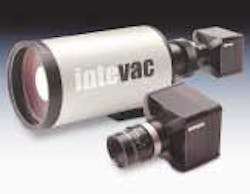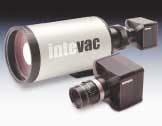Gate array speeds camera design
Optoelectronic imaging sensors, including cameras of all types, generated $325 million in North America in 2002, and that is expected to increase to $995.2 million by 2009, according to the latest findings from Frost and Sullivan (Palo Alto, CA, USA; www.frost.com). Lead analyst Daniela Carrillo believes that product differentiation, including programmability and features, is key to gaining and maintaining market share in an increasingly crowded marketplace.
Intevac (Santa Clara, CA, USA; www.intevac.com) understood the need for differentiation when designing its new intensified CMOS camera—the Nightvista. David Main, engineering group leader for commercial imaging at Intevac, says the original Nightvista design was abandoned just as it neared manufacturing. "It was based on a DSP from Texas Instruments (Dallas, TX, USA; www.ti.com). It used five circuit boards and consumed 5-W power. It was big, expensive, and undoubtedly going to have some thermal problems."
Main, who had spent 22 years as an engineering consultant in ASICs and field-programmable gate arrays (FGPAs), suggested that a FPGA could beat the power problems and improve performance while cutting power consumption and reducing cost. After evaluating several FPGA alternatives, Intevac settled on the Cyclone FPGA from Altera (San Jose, CA, USA; www.altera.com) with 20,060 logic elements. "Altera's high-density Stratix FPGA was too big, and other parts were too small," Main says, adding that in the last eight years he has switched all his FPGA designs to Altera components because of consistent past successes, FPGA tools, and support.
"I really likes the MAX+PLUS II design software," he continues. "But while I wasn't too crazy about the Quartus II design software, the Nios core embedded-processor capability and Avalon peripherals were good. The SOPC tools worked exactly as they were supposed to in a drag-and-drop build fashion, including the Nios processor and peripherals such as timers, UARTs, and flash-memory controllers."
Within two months, Intevac had a working camera design ready for manufacture. The switch from DSP to FPGA reduced five circuit boards to one and reduced the power consumption from 5 W to less than 1.9 W. "Perhaps the best advantage to the FPGA is that only 35% of the FPGA logical elements are used, leaving room for feature upgrades. If someone in Europe wants the camera modified for the PAL standard, for example, it should be easy to change the camera parameters and alter the FPGA," Main says.
In addition to low power consumption, Intevac's intensified imaging sensor allows images to be captured in light levels as low as 10-4 lux in the visible and near-infra red spectrum. Although the camera is primarily targeted at security applications, its low-light capabilities allow its use in other applications such as life sciences.
Although the camera has yet to be tested with a variety of frame grabbers, it comes with two RS232 controllers—one for local PC host and a second for gimbal/pan/tilt control—plus an RS170 I/O port for character-generation overlays. Nightvista software for the PC is used to control camera settings and viewing video. While Main declines to comment on whether Intevac would adopt a digital-output standard such as FireWire or Camera Link, he says that the FPGA has plenty of available capability, and other communications protocols were being considered.

